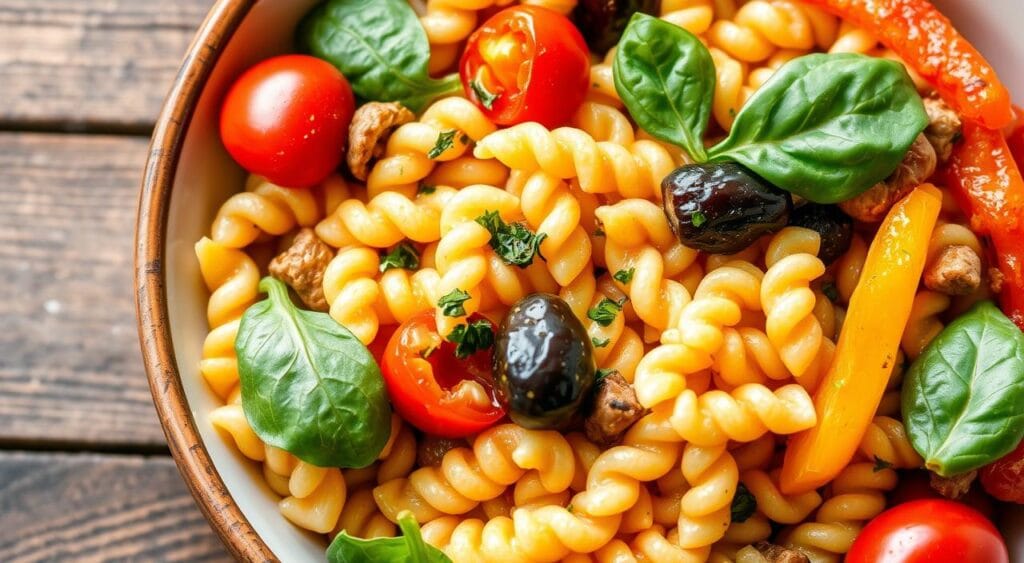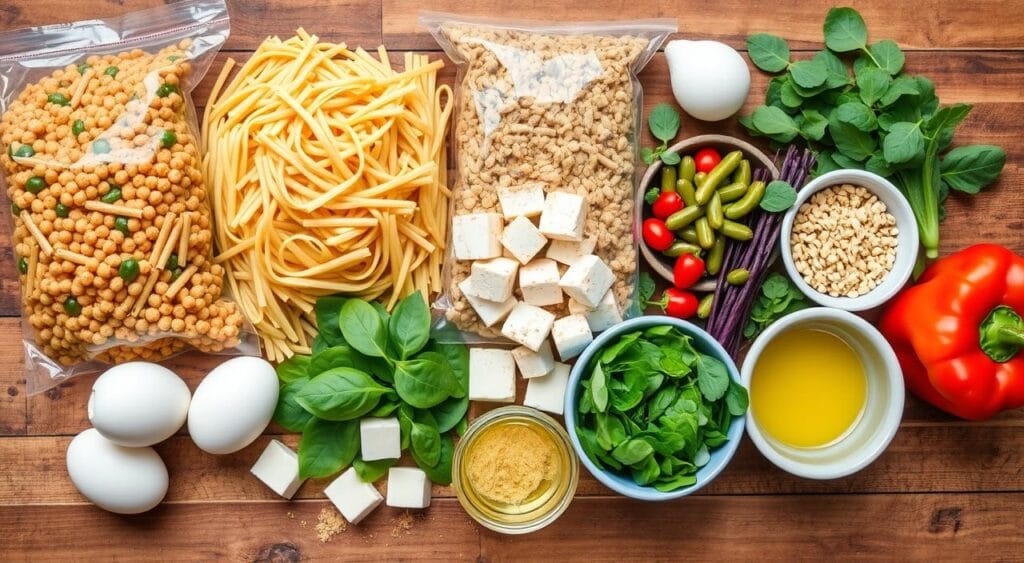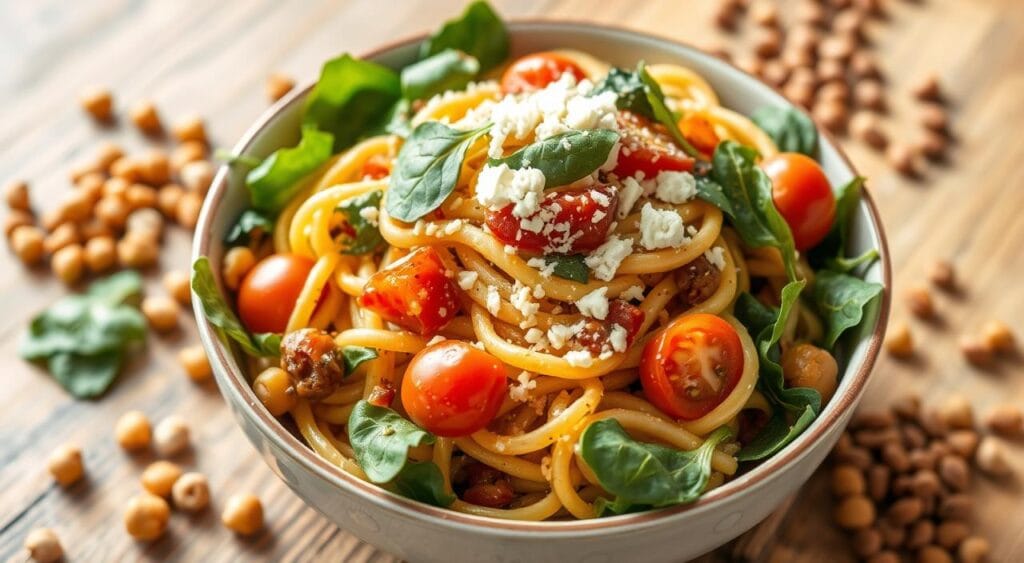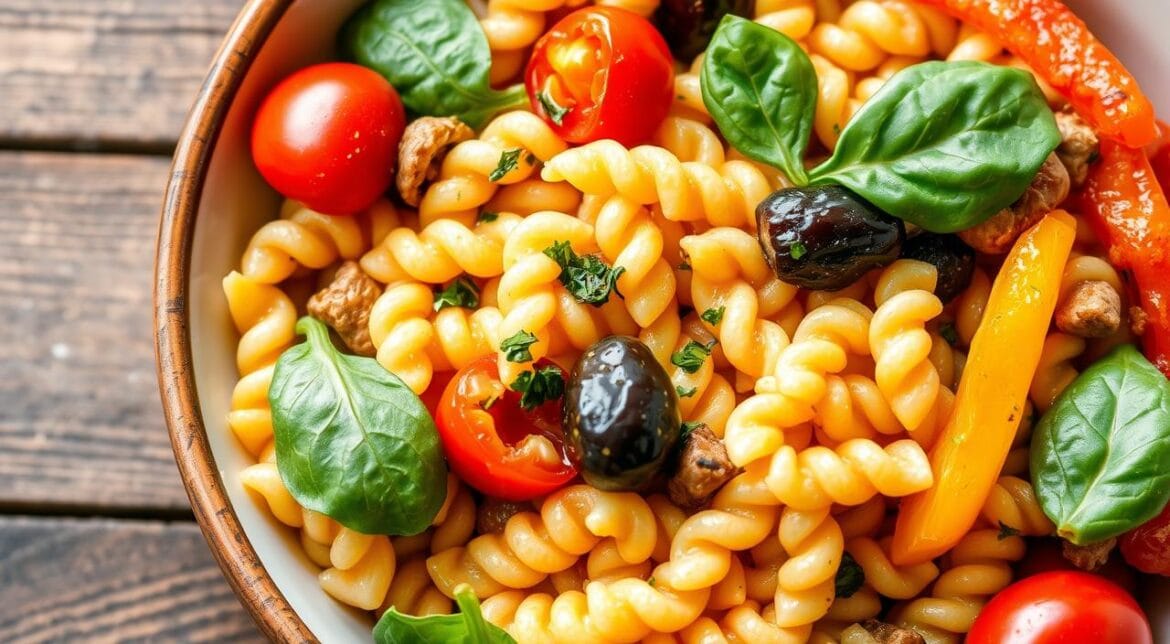Table of Contents
Is Protein Pasta Healthy? In today’s health-focused world, protein pasta is gaining popularity. It’s seen as a better choice than traditional pasta. But, is it really a healthy option?
This article will explore protein noodles in detail. We’ll look at their ingredients, nutritional value, and both the good and bad sides. We’ll also compare them to regular pasta to help you decide if they’re right for you.

Key Takeaways
- Protein pasta is made from protein-rich ingredients like beans, lentils, or egg whites, along with wheat flour.
- It often has more protein and might help control blood sugar better than regular pasta.
- The health benefits of protein pasta vary based on the ingredients and how it’s made by different brands.
- It’s a good choice for those wanting more protein, managing weight, or keeping blood sugar stable.
- Remember, everyone’s dietary needs are different. Always consult a healthcare professional before making any changes to your diet.
What Is Protein Pasta and How Is It Made
Protein pasta is a special type of pasta. It has added protein sources like legumes, whole grains, or protein powders. This makes it more nutritious and filling than regular pasta.
Common Ingredients in Protein Pasta
Protein pasta is made with ingredients that increase its protein content. Common sources include:
- Legumes like lentils, chickpeas, or beans
- Whole grains such as quinoa, brown rice, or spelt
- Isolated protein powders like pea, soy, or whey protein
Manufacturing Process
To make protein pasta, ingredients are blended with traditional pasta dough. This dough is made from wheat flour, eggs, and water. The mixture is then shaped into pasta forms like spaghetti or penne. Finally, it’s dried to remove moisture and get the right texture.
Types of Protein Sources Used
Brands use different protein sources to make their pasta more nutritious. Some popular ones are:
- Pea protein: Made from yellow split peas, it’s a plant-based source rich in amino acids.
- Chickpea protein: Ground chickpeas add protein and fiber to pasta.
- Lentil protein: Lentils are a legume that’s high in protein and other nutrients.
- Whey protein: From milk, it’s a complete protein often used in pasta.
These protein-rich ingredients make protein pasta have more protein than regular pasta. This is great for anyone looking to increase their protein intake.

The Nutritional Profile of Protein Pasta
High protein pastas are more than just high in protein. They have a mix of nutrients that traditional pasta doesn’t. This makes them a great choice for those looking for a healthier option.
These pastas are made with flours like chickpea, lentil, or pea. This increases their protein content. A serving can have 15 to 30 grams of protein, depending on the ingredients.
They also have a lot of complex carbs. This helps you feel full and gives you energy for longer. Plus, they have more fiber than regular pasta, which is good for your digestion.
| Nutritional Component | High Protein Pasta | Regular Pasta |
|---|---|---|
| Protein (per serving) | 15-30 grams | 6-8 grams |
| Carbohydrates (per serving) | 30-40 grams | 40-50 grams |
| Fiber (per serving) | 5-10 grams | 2-3 grams |
| Fat (per serving) | 3-5 grams | 1-2 grams |
High protein pastas are also packed with vitamins and minerals. They’re good sources of iron, folate, and B-vitamins. This makes them a nutritious choice for anyone looking to increase their nutrient intake.

If you’re trying to reach your fitness goals, manage your weight, or just want a healthier pasta option, high protein pastas are a great choice. Knowing their nutritional benefits helps you make a smart choice for your diet.
Is Protein Pasta Healthy? Breaking Down the Facts
Many people are choosing protein noodles over regular pasta because they think it’s healthier. But is it really good for you? Let’s look at the facts and see if protein pasta is a smart choice for your meals.
Benefits for Weight Management
Protein noodles might help you manage your weight. They have more protein, which can make you feel full longer. This could help you eat fewer calories and lose weight in a healthy way.
Research shows that eating more protein can help keep your muscles strong while you lose fat. So, protein pasta could be a good option for those trying to control their weight.
Impact on Blood Sugar Levels
Protein noodles tend to have a lower glycemic index than regular pasta. This means they don’t cause blood sugar to spike as much. This is good news for people with diabetes or anyone who wants to keep their blood sugar stable.
The protein in these noodles is digested and absorbed more slowly. This helps keep insulin levels steady and prevents big swings in blood sugar.
Digestibility and Gut Health
Protein noodles might also be good for your gut. They often contain fiber from ingredients like legumes or lentils. This can help your digestion, improve how your body absorbs nutrients, and even lower the chance of digestive problems.
But, everyone’s body is different. Some people might find that certain protein noodles upset their stomach. Always pay attention to how your body reacts and talk to a doctor if you have any issues.
In summary, protein noodles seem to have some health benefits. But, it’s important to think about what’s best for you personally. Eating them in moderation and as part of a balanced diet is the best way to stay healthy.
Comparing Regular Pasta vs. Protein Pasta
When we talk about does pasta contain protein, regular pasta and protein pasta are different. Regular pasta is made from refined wheat flour. Protein pasta, on the other hand, includes high-protein sources like legumes, nuts, or grains.
| Feature | Regular Pasta | Protein Pasta |
|---|---|---|
| Protein Content | Low (about 2-3 grams per serving) | Higher (often 10-20 grams per serving) |
| Carbohydrates | High (around 40 grams per serving) | Relatively lower (around 20-30 grams per serving) |
| Texture | Soft and tender | Can be slightly firmer or chewier |
| Taste | Mild, neutral flavor | May have a slightly nutty or earthy taste depending on the protein source |
| Cooking Time | Typically cooks faster (8-10 minutes) | May take a bit longer to cook (10-15 minutes) |
Protein pasta has more protein, which can help you feel full longer. It also has less carbs, which is good for blood sugar control. But, it might taste and feel different from regular pasta, which some people don’t like.
Choosing between regular pasta and does pasta contain protein depends on what you like and need. Try different protein pasta types to see what works best for you.
Protein Content: How Much Protein Do You Really Get?
High protein pastas are popular, but how much protein do they really offer? The amount of protein varies among brands and types. Let’s explore protein quality, absorption, and how these pastas fit into your daily needs.
Protein Quality and Absorption
Protein quality matters a lot. The amino acid profile, digestibility, and bioavailability affect how well your body uses it. Whey, egg, or pea protein are high-quality and easily absorbed.
Daily Protein Requirements
Protein needs vary by age, activity level, and health. Most adults need 46-56 grams daily. Athletes or those building muscle might need more. High protein pastas can help meet these needs.
Best Times to Eat Protein Pasta
- After a workout: It helps repair and rebuild muscles.
- As part of a balanced breakfast: Keeps you full and energized.
- For a protein-packed lunch or dinner: Pair with veggies, healthy fats, and other proteins for a balanced meal.
Protein content and quality in pasta vary. Always check labels and choose what fits your needs. Adding high protein pastas to your diet can boost your protein intake and support health.
| Protein Pasta Brand | Protein Content (per serving) | Protein Source |
|---|---|---|
| Banza Chickpea Pasta | 25g | Chickpeas |
| Explore Cuisine Organic Edamame Pasta | 24g | Edamame |
| Barilla Protein+ Pasta | 17g | Lentils, peas, chickpeas |
| Tolerant Red Lentil Pasta | 21g | Red lentils |
Who Should Consider Eating Protein Pasta
Protein noodles, or protein pasta, are great for many people. They help athletes grow muscle and help those watching their weight feel full. Let’s see who benefits most from these protein-rich foods.
Athletes and Active Individuals
Protein is key for athletes to recover and grow muscles. Protein noodles are a good source of protein. They help athletes meet their protein needs and support their health.
Weight Management and Diabetes
Protein noodles are great for weight management and blood sugar control. They make you feel full, which can help with weight loss. They also slow down blood sugar spikes, good for diabetes or prediabetes.
Vegetarians and Vegans
Vegetarians and vegans often need more protein. Protein noodles are a plant-based option. They offer a lot of protein from legumes, soy, or pea protein. This helps vegetarians and vegans get enough protein.
But, protein noodles aren’t for everyone. It’s important to think about your diet and health. Talking to a doctor or dietitian can help find the right protein pasta for you.
Popular Brands and Their Protein Sources
The market offers a wide range of high protein pastas. You can find everything from traditional wheat-based options to innovative ones made with protein-rich ingredients. Let’s look at some top brands and their unique protein sources.
Top-Rated Protein Pasta Brands
- Banza – Made from chickpeas, providing a significant protein boost compared to regular pasta.
- Explore Cuisine – Offers a range of protein-packed pastas made from beans, lentils, and organic edamame.
- Barilla Protein+ – A wheat-based pasta fortified with added protein from egg whites and legumes.
- Tolerant – Features a line of plant-based pastas made from red lentils, green lentils, and black beans.
- Eat Proper – Crafts pastas using a blend of high-quality ingredients like pea protein, brown rice, and quinoa.
Price Comparison Guide
| Brand | Protein Source | Price per Serving (8 oz) |
|---|---|---|
| Banza | Chickpeas | $1.50 |
| Explore Cuisine | Beans, Lentils, Edamame | $2.00 |
| Barilla Protein+ | Wheat, Egg Whites, Legumes | $1.25 |
| Tolerant | Lentils, Beans | $1.75 |
| Eat Proper | Pea Protein, Brown Rice, Quinoa | $2.25 |
As you can see, the protein sources and pricing for these high protein pastas can vary significantly. When choosing the best option for your needs, consider factors like protein content, dietary preferences, and your budget.
How to Cook Protein Pasta Perfectly
Cooking protein-rich pasta is a bit different than regular pasta. But, with a few simple tips, you can get the perfect texture and taste. Whether it’s made from lentils, chickpeas, or other plant-based sources, these guidelines will help you enjoy your protein-packed pasta dish.
Bring Plenty of Water to a Boil
Use a large pot with plenty of water when cooking protein noodles. This prevents the pasta from sticking together and ensures even cooking. Make sure the water is boiling before adding your protein pasta.
Adjust Cooking Time
Protein noodles cook a bit faster than traditional pasta. Begin checking for doneness a few minutes earlier than the package recommends. The pasta should be al dente, with a gentle bite, not too soft or mushy.
Avoid Overcrowding the Pot
It’s tempting to cook a lot of protein noodles at once. But, overcrowding can cause clumping and uneven cooking. Cook your protein pasta in batches to ensure each serving is perfectly cooked.
Don’t Rinse the Pasta
Unlike regular pasta, don’t rinse your cooked protein noodles under cold water. This can wash away the starches that help the sauce stick. Simply drain the pasta and add it directly to your sauce or other ingredients.
Experiment with Cooking Methods
You can also try baking or air-frying protein pasta for a unique texture. Baking gives a crispy, al dente bite, while air-frying adds a crunchy exterior. Adjust cooking times when using these methods.
By following these tips, you can cook protein noodles to perfection. Enjoy all the nutritional benefits they offer. Experiment with different protein sources and cooking techniques to find your favorite way to prepare protein-rich pasta.
Creative Ways to Add More Protein to Your Pasta Dishes
Protein pasta is a great start for a healthy meal. But, you can make it even better by adding more protein. Try different sauces and toppings to increase the protein in your pasta. This way, you’ll get a balanced and filling meal.
High-Protein Sauce Options
Don’t stick to just tomato or cream sauces. Try these protein-rich alternatives to make your pasta more nutritious:
- Pesto made with nuts, seeds, or how to add protein to pasta protein powder
- Meat-based sauces like bolognese or meatball marinara
- Creamy, cheese-based sauces with Greek yogurt or cottage cheese
- Lentil or bean-based sauces for a plant-based protein boost
Protein-Rich Toppings
Make your pasta dish better with protein-rich toppings. Here are some ideas:
- Grilled or sautéed chicken, shrimp, or tofu
- Roasted chickpeas or edamame
- Crumbled feta, parmesan, or other cheese
- Chopped nuts, seeds, or how to add protein to pasta nut butters
- Hard-boiled eggs or crispy bacon
Adding these high-protein elements can turn a simple pasta dish into a nutritious meal. You’ll feel full and energized.
“Protein is a vital macronutrient that aids in building and repairing tissues, making it beneficial to add more to your pasta dishes for improved health.”
Potential Drawbacks and Considerations
Protein pasta has many health benefits, but it also has some downsides. The taste and texture can be different from regular pasta. This might not feel the same as the pasta you’re used to.
Also, protein pasta can cost more than regular pasta. This might be a problem for some people. It’s important to think about whether the health benefits are worth the extra money.
Some people might feel uncomfortable or bloated when they start eating protein pasta. This is because of the extra protein. It’s a good idea to start slowly and watch how your body reacts. This helps make sure it’s okay for you.
Even with these issues, many people think the good points of protein pasta are worth it. It can help with weight and blood sugar. So, it’s up to you to decide if it’s right for you.
| Potential Drawbacks | Considerations |
|---|---|
| Difference in taste and texture compared to traditional pasta Higher cost compared to regular pasta Potential digestive issues for some individuals | Evaluate personal preferences and health goals Introduce protein pasta gradually to monitor your body’s response Compare prices and determine if the benefits justify the additional cost |
Despite these points, many people find the benefits of is protein pasta healthy are worth the minor drawbacks. It can be a fantastic addition to a nutritious diet.
Conclusion
Exploring is protein pasta healthy shows it can be a good choice for your diet. It’s not a perfect swap for regular pasta, but it has its perks. It’s great for those looking to eat more protein or control their weight.
To get the most out of protein pasta, eat it as part of a balanced diet. Include a variety of whole foods. Watch your portion sizes and choose sauces and toppings that are full of nutrients. This way, you can enjoy protein pasta without losing nutritional value.
Whether or not to add is protein pasta healthy to your diet depends on your health goals and tastes. Knowing how this pasta works can help you make choices that are good for you. It can lead to a healthier and more enjoyable eating routine.
FAQ
What is protein pasta and how is it made?
Protein pasta is a type of pasta with more protein than regular pasta. It’s made by adding protein-rich ingredients like legumes or protein powders to the dough.
What are the common ingredients used in protein pasta?
Protein pasta often includes pea protein, chickpea flour, and lentil flour. Some brands also add quinoa or brown rice for extra protein.
How does the nutritional profile of protein pasta compare to regular pasta?
Protein pasta has more protein, less carbs, and more fiber than regular pasta. The exact nutrition depends on the ingredients used.
What are the potential health benefits of eating protein pasta?
Eating protein pasta can help with weight management and blood sugar control. It also promotes digestive health thanks to its high fiber content.
How much protein do you actually get from protein pasta?
Protein pasta’s protein content varies, from 10 grams to over 30 grams per serving. Always check the nutrition label for exact amounts.
Who should consider eating protein pasta?
Athletes, vegetarians, and those managing weight or blood sugar might find protein pasta helpful. However, those with dietary restrictions should consult a healthcare professional first.
What are some popular brands of protein pasta and how do they compare?
Top brands include Banza, Explore Cuisine, and Barilla. They offer different protein sources and vary in price, texture, and nutrition.
How can you cook protein pasta perfectly?
Follow the package instructions for cooking protein pasta. Use the right water-to-pasta ratio and avoid overcooking to keep the texture right.
How can you add more protein to your pasta dishes?
Use protein pasta and high-protein sauces like Greek yogurt or nut creams. Top with protein-rich ingredients like grilled chicken or chickpeas.
What are some potential drawbacks or considerations with protein pasta?
Protein pasta might taste or feel different than regular pasta. It can be more expensive and cause digestive issues for some. Try different brands and cooking methods to find what works best for you.

